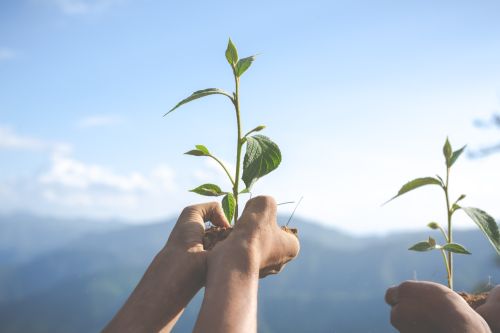Exploring the Potential of Mechanical Trees


Cut through the green tape
We don’t push agendas. At Net Zero Compare, we cut through the hype and fear to deliver the straightforward facts you need for making informed decisions on green products and services. Whether motivated by compliance, customer demands, or a real passion for the environment, you’re welcome here. We provide reliable information—why you seek it is not our concern.
As the world grapples with the escalating threat of climate change, scientists and engineers are continually searching for innovative solutions to reduce carbon dioxide (CO2) levels in the atmosphere. Among the emerging technologies, "mechanical trees" stand out as a promising advancement in carbon capture and storage (CCS). These artificial structures are designed to mimic the natural process of photosynthesis, capturing CO2 from the air and storing it in a way that helps mitigate the effects of global warming.
What Are Mechanical Trees?
Mechanical trees, also known as direct air capture (DAC) devices, are a type of artificial technology that captures CO2 directly from the atmosphere. Unlike traditional carbon capture methods, which typically involve capturing emissions at the source (such as from power plants or factories), mechanical trees can be deployed anywhere.
The concept of mechanical trees was developed by researchers at Arizona State University, led by Dr. Klaus Lackner, a pioneer in the field of carbon capture. These devices are designed to absorb CO2 from the air using specialized materials that bind with the gas. Once captured, the CO2 can be either stored underground or utilized in various industrial processes, such as the production of synthetic fuels.
How Do Mechanical Trees Work?
These devices consist of vertical columns, or "trees," lined with materials that have a high affinity for CO2. As air flows over these materials, the CO2 molecules are absorbed and trapped.
Periodically, the captured CO2 is released from the materials by changing environmental conditions, such as humidity or temperature, which triggers the release of the gas. The CO2 is then collected, compressed, and either stored underground in geological formations or repurposed for industrial uses.
One of the key advantages of mechanical trees is their passive nature. Unlike other carbon capture technologies that require significant energy inputs, mechanical trees can operate with minimal energy, relying largely on natural wind patterns to bring air into contact with the capture materials. This makes them an energy-efficient and cost-effective solution for reducing atmospheric CO2 levels.
Materials Used in Mechanical Trees
1. Sorbents: The Core Absorptive Material
The primary material used in mechanical trees is a type of sorbent, which is a substance that can selectively absorb or adsorb gases from the air. In the context of mechanical trees, sorbents are designed to bind specifically with CO2 molecules. The most common types of sorbents used in mechanical trees are based on solid adsorbents, such as:
Amine-Functionalized Sorbents: These materials are infused with amine groups, which have a high affinity for CO2. Amines react with CO2 to form carbamate compounds, effectively capturing the gas from the air. Amine-based sorbents are widely used because of their strong binding capability with CO2 and their ability to release the gas under controlled conditions for collection.
Hydroxide-Based Sorbents: Some mechanical trees may use hydroxide materials, such as sodium hydroxide (NaOH) or calcium hydroxide (Ca(OH)2), which chemically react with CO2 to form stable carbonates. These materials are effective at capturing CO2 but typically require more energy to regenerate (release the CO2) compared to amine-based sorbents.
2. Structural Materials
Lightweight, Durable Framework: The structure of mechanical trees is typically made from lightweight, durable materials like aluminium or advanced composites. These materials need to withstand environmental conditions, including wind, rain, and temperature fluctuations, while maintaining structural integrity over long periods.
Porous Surfaces: The materials used to coat or form the surfaces where CO2 capture occurs are designed to be highly porous, maximizing the surface area available for gas interaction. This porosity enhances the efficiency of CO2 capture by allowing more air to come into contact with the sorbent materials.
Advantages of Mechanical Trees
Mechanical trees offer several benefits that make them a compelling option for carbon capture:
Scalability: Mechanical trees can be deployed in large numbers across various locations, including urban areas, deserts, and farmlands. This scalability is crucial for addressing the global scale of carbon emissions.
Low Energy Consumption: Since mechanical trees do not require fans or other mechanical devices to draw in air, they consume significantly less energy than other DAC technologies.
Versatility: Mechanical trees can be used in a variety of settings and do not need to be located near emissions sources, unlike traditional carbon capture systems.
Potential for Negative Emissions: When combined with carbon storage or utilization, mechanical trees have the potential to create "negative emissions," meaning they can remove more CO2 from the atmosphere than is being emitted.
Considerations
Despite their promise, mechanical trees also face several challenges that need to be addressed before they can be widely deployed:
Cost: The initial costs of developing and deploying mechanical trees are high, although economies of scale and technological advancements could reduce these costs over time.
Storage and Utilization: Captured CO2 needs to be either stored underground or used in a way that prevents it from returning to the atmosphere. Ensuring safe and long-term storage is a critical challenge.
Public Acceptance: As with any new technology, gaining public support and regulatory approval is essential for the widespread adoption of mechanical trees. Addressing concerns about environmental impacts and land use will be crucial.
Carbon Collect: The MechanicalTree™
Carbon Collect is a company that has commercialized the mechanical tree technology developed by Dr. Klaus Lackner's team at Arizona State University. The company has taken the foundational research and is working on scaling up the production and deployment of mechanical trees. The company is focused on making the technology commercially viable and accessible for large-scale deployment.
As the primary company directly involved in producing mechanical trees, Carbon Collect is at the forefront of this innovative approach to carbon capture.
The mechanical trees developed by Carbon Collect are vertical, column-like structures that mimic the natural process of photosynthesis but in a mechanical form. These "trees" are over 10 meters tall and are equipped with materials that have a high affinity for CO2, allowing them to capture the gas from the ambient air passively. They do not require significant energy inputs like fans or pumps to draw in air. Instead, they rely on natural wind patterns to expose the capture materials to atmospheric CO2.
One of the key advantages of Carbon Collect's technology is its scalability. The mechanical trees can be deployed in large numbers across various landscapes, from urban areas to deserts, making it possible to capture CO2 on a significant scale.
Pilot Projects
1. Arizona State University’s Initial Deployment
Location: Tempe, Arizona
Objective: The initial pilot project for mechanical trees was conducted at Arizona State University (ASU) under the leadership of Dr. Klaus Lackner. The primary goal was to test the basic functionality of the mechanical tree design, focusing on CO2 capture efficiency, energy use, and material durability in an arid environment.
Outcome: The project successfully demonstrated that mechanical trees could capture CO2 from the atmosphere using passive methods. The early prototypes were able to absorb significant amounts of CO2, validating the core concept. However, the trial also highlighted the need for further optimization of the materials used to improve the rate of CO2 absorption and the energy efficiency of the release process.
2. The Center for Negative Carbon Emissions (CNCE) Pilot
Location: Arizona State University Campus
Objective: The CNCE at ASU, where Dr. Lackner serves as the director, has been central to developing and testing mechanical trees. A key pilot project involved the deployment of several mechanical tree units on the ASU campus to study their performance in a semi-controlled outdoor environment. This project aimed to evaluate the long-term durability of the materials and the feasibility of scaling up the technology.
Outcome: The pilot provided valuable data on the mechanical trees' performance over extended periods. It revealed that while the technology is promising, certain challenges, such as maintaining the efficiency of the sorbent materials over multiple capture and release cycles, needed to be addressed. The pilot also underscored the importance of designing units that could withstand varying weather conditions.
The Future of Mechanical Trees
As of now, mechanical trees are in the early stages of commercialization and deployment. As research and development continue, these devices could become an integral part of a broader strategy to reduce atmospheric CO2 levels and achieve global climate goals.
The potential of mechanical trees lies not just in their ability to capture carbon but also in their adaptability to various environments and their capacity for large-scale deployment.
Cost
The cost of mechanical trees, specifically the MechanicalTree™ developed by Carbon Collect, ranges between $30,000 and $100,000 per unit. In terms of operational costs, the capture cost is projected to be less than $100 per ton of CO₂, which could decrease further as production scales up. This makes mechanical trees a potentially economically viable solution for carbon capture compared to other methods currently available.

More related content

Carbon Accounting vs. Climate Risk Management - What's the Difference

Industry Classification Systems used in the Green Economy

Hard Facts on Renewable Energy: Breaking Down the Real Economic Ben...
